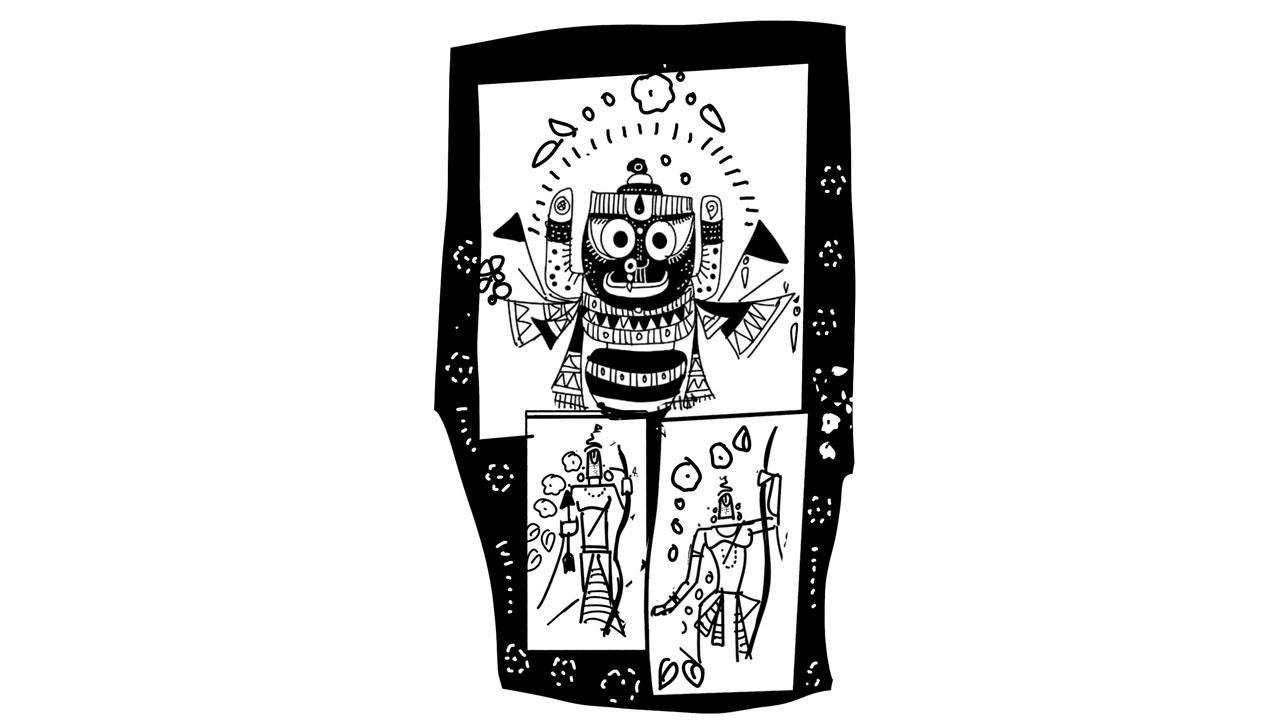Politicians casually transplant these gods across the land to suit their agenda, confusing devotees.

Illustration/Devdutt Pattanaik
 As the chariot rolls out of the Jagannath temple in Odisha this year, some may ask, is Jagannath now the favoured ‘national’ god, overshadowing Ram of Ayodhya? But words like national come with borders. Cosmos has no borders. Jagat means cosmos.
As the chariot rolls out of the Jagannath temple in Odisha this year, some may ask, is Jagannath now the favoured ‘national’ god, overshadowing Ram of Ayodhya? But words like national come with borders. Cosmos has no borders. Jagat means cosmos.
India is full of cosmic gods who take local form—Vitthala is the local form of Vishnu in Maharashtra, Tirupati is the local form of Vishnu in Andhra Pradesh, Ranganathaswamy is the local form of Vishnu in the Kaveri river. Politicians casually transplant these gods across the land to suit their agenda, confusing devotees.
As per local temple philosophy in Puri, Jagannath is both ‘avatari’ and ‘avatar’—he is the infinite one (Narayana) and the finite one (Ram). What is infinite is the idea of that which lasts forever. What is finite is the form—the icon made of perishable materials (wood, cloth, resin, paint) which is renewed every 10 to 15 years. This co-existence of infinite-finite, permanent-impermanent is at the core of Hindu thought, an idea that escapes the establishment that understands only transaction.
Politicians prefer the “saviour” god of Middle Eastern mythology—the messiah who kills bad people using flood and fire, and rescues good people; his people, the chosen ones. This division of good-bad, right-wrong is not Hindu thought. Ram is not the “saviour” who kills bad people; Krishna is not the “saviour” who kills bad people. In the ‘jagat’ of Jagannath, all kinds of plants, animals, minerals and humans exist. Serpents and wolves are not evil. They are part of an ecosystem. Bad and good is a function of needs. With time, needs change. Rain is good in drought, not during floods. This fluidity is absent in rule-based monotheistic faiths.
Hindu temples are different from Buddhist and Jain shrines. In Hindu temples, the divine is visualised as both male and female. Monastic establishments shun the female form, placing place it on lower pedestals. The Ram temple of Ayodhya does not include the female form . Neither wife nor mother nor sister. The Jagannath temple includes his sister (Subhadra), wife (Lakshmi), mother (Vimala). The deity in the new Ram temple of Ayodhya has an unusual form—vertical, more like a Buddha or Tirthankara, or the image of Akshar- Purushottama or Nara-Narayana found in Swami Narayan temples. It distances itself from the graceful curve of ‘tri-bhanga’ (thrice bent stance) seen in traditional Ram and Krishna statues, as in Chola bronze statues, where even a warrior rests on his bow-and-arrow like a dancer.
The statue at Jagannath is incomplete. He has no feet, no ears, no eyelids, no hands. But he is always smiling, letting his devotees visualise him whatever way they wish. And so regularly, the image is dressed using various masks and costumes (bhesa)—he can be Nagarjuna one day, a warrior with many weapons, or even Gajamukha or elephant-headed to please the devotee who longs to see Ganesha, or Hari-Hara for the Shiva-bhakt. This is a god of accommodation, of inclusion, who rides out of the temple each year because he knows temple administrators, over generations, have not let everyone enter the temple freely. Thus the limitless deity manages the limited devotees, nudging them playfully, towards wisdom.
The author writes and lectures on the relevance of mythology in modern times. Reach him at devdutt.pattanaik@mid-day.com
 Subscribe today by clicking the link and stay updated with the latest news!" Click here!
Subscribe today by clicking the link and stay updated with the latest news!" Click here!








